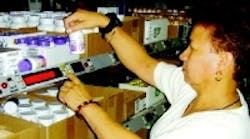Integrating enterprise resource planning (ERP), warehouse management software (WMS) and transportation management software (TMS) gives distributors increased accuracy, efficiency and customer satisfaction. There is a quick return on investment, too. The typical payback period is six to nine months.
After integrating its software systems, Uvex Sports, Inc. (Cranston, R.I.), a 10-employee distributor of protective sports eyewear and other protective sports gear, grew from $1.2 million in sales to $5.2 million, and only had to hire two more employees.
Bruce Campbell, Controller at Uvex, says the integration makes it possible to do more with less labor. It also lets Uvex meet the different requirements of Internet customers and retailers like Sports Authority, Wal-Mart and Cosco. "To them, we look like a big player even though we are small fish. That's what the software allows you to do. It makes you be able to play with the big boys, but also be able to stay efficient," he explains.
Integrating software is not easy, but today it is more feasible because software can be written in the same source language and built on the same software platform. The good news for distributors is that third-party companies are working together to create end-to-end integrated software products. As these products become more standard, costs drop and more midsized companies can afford them.
A basic integration can cost $25,000 to $50,000. The price for a complete project, including software, hardware and implementation services could run as high as $500,000. Business complexity and unique needs also increase integration costs. For example, says Dale Jeffries, president, Radio Beacon Inc. (Toronto), "Distributors are seeing an increase in the complexity of retail compliance requirements, so it is critical for them to be able to leverage tools which simplify the process and make their business easier to manage and less costly."
Over the years, Uvex has assembled a team of likeminded third-party companies that work together to integrate their software to meet Uvex' changing business needs. According to Uvex's Campbell, the partner companies have a similar philosophy and approach, which centers on the value of teamwork and the importance of looking ahead and adapting to change.
Blue Moon Industries (Providence, R.I) implemented Uvex' first accounting system, Great Plains, 10 years ago. Since then, Great Plains evolved into Microsoft Business Solutions-Great Plains and includes financial, distribution, and eCommerce modules.
Recently, Uvex partnered with Radio Beacon, Blue Moon Industries and vSync (Columbus, Ohio) to help it simplify compliance process while driving efficiency gains and growth.
In the closed-loop end-to-end system they developed for Uvex, vSync's Warehouse Management Integration software takes order information from customers and electronically creates an order in Microsoft's Great Plains, which is now Uvex' ERP system. Next, Blue Moon's integration takes over and automatically sends this information to Uvex's Radio Beacon WMS, which after fulfillment, integrates with the UPS WorldShip manifesting system. UPS sends back the information to the ERP system to update the fulfillment transaction for invoicing. It updates the shipping cost from the manifesting system, then creates an automatic shipping notice and an invoice, which goes back to the trading partner.
There are a number of standard plug-in components that are part of this integration suite. Since Uvex imports its product, it uses Blue Moon's ContainerManagement module for importers and other retail-compliant modules, which are able to handle customer specifics like labels and pack sizes so Uvex doesn't get fines from big retailers for noncompliance.
Do-It-Yourself Integration
A few mid-market companies have the wherewithal to integrate their own software. One such company is Vitacost (Boynton Beach, Fla.). It is a direct-to-consumer company that sells vitamins, diet and natural health products through catalogs and over the Internet.
Wayne Gorsek, CEO of Vitacost, says companies need to do their own integration because they know their business needs best. His team integrated HighJump's (Eden Prairie, Minn.) Supply Chain Advantage with Microsoft Business Solutions-Great Plains. Its carriers include UPS and USPS.
After evaluating several ERP warehouse modules, Gorsek says he chose HighJump because its breadth of functionality and cost-effective approach to making business process changes support his company's rapidly growing volumes and ongoing competitive advantage.
The integration is already improving Viacost's productivity. Throughput is up by approximately 33% while keeping labor constant. It is also streamlining the receiving process for thousands of items arriving daily from more than 200 suppliers. Additional efficiencies have come in the area of inventory management. The system's track-and-trace functions let Vitacost account for each item's precise location at each stage of the supply chain, essential to carrying out fast recalls if required.
With its integrated system in place, Vitacost's team transformed paper-based operations into an optimized, wireless warehouse environment. The company recently implemented a pick-to-light system that interfaces directly with HighJump's Supply Chain Advantage to direct picking and replenishment. Vitacost is planning to use the system in locations in the United States and abroad.
Although Vitacost and Uvex approached integration differently, moving forward both companies expect their systems will continue to meet their changing business needs and let them maintain consistently high levels of year-to-year growth.
Vitacost increased its throughput by 33% without increasing labor when it starting using HighJump software in an integrated software system.



